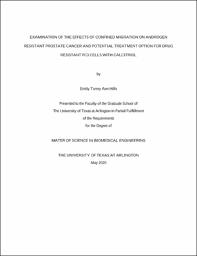
ATTENTION: The works hosted here are being migrated to a new repository that will consolidate resources, improve discoverability, and better show UTA's research impact on the global community. We will update authors as the migration progresses. Please see MavMatrix for more information.
Show simple item record
| dc.contributor.advisor | Kim, Young-tae | |
| dc.contributor.advisor | Nguyen, Kytai | |
| dc.contributor.advisor | Hong, Yi | |
| dc.creator | Hills, Emily Torrey Ann | |
| dc.date.accessioned | 2021-06-03T15:34:31Z | |
| dc.date.available | 2021-06-03T15:34:31Z | |
| dc.date.created | 2020-05 | |
| dc.date.issued | 2020-05-04 | |
| dc.date.submitted | May 2020 | |
| dc.identifier.uri | http://hdl.handle.net/10106/29864 | |
| dc.description.abstract | When localized to the prostate, prostate cancer (PCa) has a near 100% 5-year survival rate, however, when prostate cancer metastasizes the survival rate drastically drops to around 30%. The low death rate of primary PCa is due to the wealth of knowledge we have of non-metastatic cancer and the sufficient treatment regimens. However, this understanding does not apply to metastatic cancer, so therapies are greatly lacking. To gain a better understanding of the invasion process for PCa we utilized microchannel technology to uncover the differences between migratory and non-migratory PCa. Specifically, the following study examines the effects of confined migration on castrate-resistant prostate cancer cell line PC3 in terms of phenotypical shifts and genetic aberrations. Based off our findings and current literature, we believe that migration through a 3D confined space induces epigenetic changes that boost cancer stem cell (CSC) like behavior, expression of efflux and detoxifying proteins and temporarily cause cell cycle arrest which all contribute to a dramatic increase in therapeutic resistance. PC3 cell viability following treatment with doxorubicin was nearly 10 times higher in cells which had undergone migration in comparison to cells which had not. Though the increased resistance is multifactorial, we focus on how the chemotherapy resistance is a result of migration induced escalation in drug deactivation and drug discharge. Furthermore, we show that PC3 cells which experience confined migration are able to maintain a dormant phenotype for up to 7 days ultimately increasing the cells therapy resistant capabilities. In addition, we show some of the major CSC markers for PCa increased expression after migration including CD133, ALDAH1, Nanog, and EGFR. Due to the increase in resistance we examined if calcitriol (Vitamin D) could enhance the antitumor activity of chemotherapeutic drugs. Our work demonstrates that calcitriol causes migration induced therapy resistant PC3 cells to become greatly more responsive to treatment. With this information we provide a potentially novel method for treatment of therapy resistant prostate cancer using FDA approved calcitriol. | |
| dc.format.mimetype | application/pdf | |
| dc.language.iso | en_US | |
| dc.subject | Prostate cancer | |
| dc.subject | Confined migration | |
| dc.subject | Vitamin D | |
| dc.subject | Calcitriol | |
| dc.subject | PC3 | |
| dc.subject | Microchannel | |
| dc.title | Examination Of The Effects of Confined Migration on Androgen Resistant Prostate Cancer And Potential Treatment Option for Drug Resistant PC3 Cells with Calcitriol | |
| dc.title.alternative | Examination Of The Effects of Confined Migration on Androgen Resistant Prostate Cancer And The Use Of Calcitriol As A Treatment Option For Drug Resistant PC3 Cells | |
| dc.type | Thesis | |
| dc.degree.department | Bioengineering | |
| dc.degree.name | Master of Science in Bioengineering | |
| dc.date.updated | 2021-06-03T15:34:31Z | |
| thesis.degree.department | Bioengineering | |
| thesis.degree.grantor | The University of Texas at Arlington | |
| thesis.degree.level | Masters | |
| thesis.degree.name | Master of Science in Biomedical Engineering | |
| dc.type.material | text | |
Files in this item
- Name:
- HILLS-THESIS-2020.pdf
- Size:
- 969.0Kb
- Format:
- PDF
This item appears in the following Collection(s)
Show simple item record


